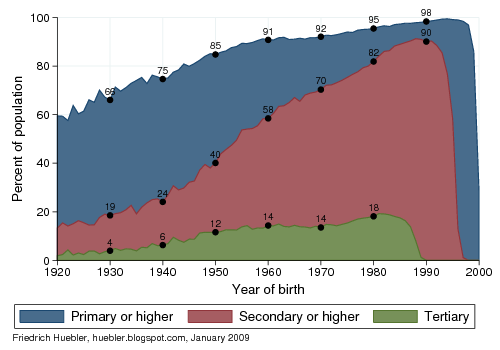The net enrollment ratio (NER) in primary education is one of the
official indicators for the
Millennium Development Goal of universal primary education. The primary NER is the share of children of primary school age that are enrolled in primary school.
| Primary NER | = | Number of children of primary school age enrolled in primary school |
| Number of children of primary school age |
If all children of primary school age are enrolled in primary school, the primary NER is 100 percent. A primary NER below 100 percent means that not all children of primary school age are in primary school; some may be out of school, some may be in preschool, in secondary school or in other forms of education. By definition, the NER cannot exceed 100 percent.
The gross enrollment ratio (GER) is a related indicator. The primary GER indicates how many children, regardless of their age, are enrolled in primary school, relative to the population of primary school age.
| Primary GER | = | Number of children enrolled in primary school |
| Number of children of primary school age |
The value of the GER can exceed 100 percent. Values above 100 percent mean that some children above or below primary school age are in primary school. A GER above 100 percent is usually an indicator of overage enrollment, for example due to repetition or late entry.
Ideally, all children in a country enter primary school at the official primary school entrance age and graduate from the final primary grade after the
official duration of primary school, for example after four or six years. In this case, the primary NER would be 100 percent and universal primary education would be achieved. If no children repeated a grade, the primary GER would also be 100 percent. If we assume that some children have to repeat a grade and remain in primary school although they have reached official secondary school age, the primary GER would be slightly above 100 percent.
However, we can demonstrate that a primary NER of 100 percent is not a necessary condition for universal primary education. Similarly, the primary GER can be below 100 percent in a country, although universal primary education has been achieved. For the demonstration we refer to data for Japan. According to the
Global Education Digest 2009 by the
UNESCO Institute for Statistics, Japan has achieved universal primary education with a primary NER and GER of 100 percent in 2007, the most recent year with data.
What would happen to the NER and GER if Japanese children systematically entered and graduated from primary school one year early or one year late? These hypothetical situations can be simulated with data from the
World Population Prospects 2008 by the
UN Population Division. Table 1 lists the estimated population of Japan between 5 and 12 years of age in the year 2009.
Table 1: Estimated population of Japan between 5 and 12 years, 2009
Age
| Population |
| 5 years | 1,120,774 |
| 6 years | 1,134,317
|
| 7 years | 1,145,758
|
| 8 years | 1,155,440
|
| 9 years | 1,163,697
|
| 10 years | 1,171,297
|
| 11 years | 1,179,006
|
| 12 years | 1,185,028
|
| 5-10 years | 6,891,283 |
| 6-11 years | 6,949,515 |
| 7-12 years | 7,000,226 |
Source: UN Population Division. 2009.
World Population Prospects: 2008 Revision.
Scenario 1: entry and graduation at official age
Primary school in Japan has 6 grades and the official primary school age is 6 to 11 years. If all children enter primary school at age 6 and graduate after 6 years, the primary NER and GER can be calculated as follows.
| Primary NER | = | Number of children of primary school age enrolled in primary school |
| Number of children of primary school age |
| = | 6,949,515 / 6,949,515 |
| = | 100% |
Because there is no overage or underage enrollment, the number of children in primary school is identical to the number of children of primary school age (6 to 11 years) and thus the primary GER is identical to the primary NER.
| Primary GER | = | Number of children enrolled in primary school |
| Number of children of primary school age |
| = | 6,949,515 / 6,949,515 |
| = | 100% |
Scenario 2: early entry
If all children enter and graduate from primary school one year early, the primary NER and GER are no longer 100 percent. The population of primary school age (6-11 years) is still 6,949,515, but in this age group only children between 6 and 10 are in primary school, in addition to children aged 5 years. In this scenario, children age 11 are already in secondary school. The number of children of primary school age enrolled in primary school is therefore 6,949,515 - 1,179,006 = 5,770,509 and the primary NER is no longer 100 percent but 83 percent.
Primary NER
(early entry) | = | Number of children of primary school age enrolled in primary school |
| Number of children of primary school age |
| = | 5,770,509 / 6,949,515 |
| = | 83.0% |
The primary GER is still near 100 percent because the population in primary school (5-10 years) is similar to the population of primary school age (6-11 years).
Primary GER
(early entry) | = | Number of children enrolled in primary school |
| Number of children of primary school age |
| = | 6,891,283 / 6,949,515 |
| = | 99.2% |
Scenario 3: late entry
Now assume that all children enter and graduate from primary school one year late. Only children between 7 and 12 years are in primary school. Of the population of primary school age (6-11 years) only those between 7 and 11 are in primary school, in addition to children aged 12 years. The number of children of primary school age enrolled in primary school is therefore 6,949,515 - 1,134,317 = 5,815,198 and the primary NER is now 83.7 percent.
Primary NER
(late entry) | = | Number of children of primary school age enrolled in primary school |
| Number of children of primary school age |
| = | 5,815,198 / 6,949,515 |
| = | 83.7% |
As in scenario 2 with early entry, the primary GER is near 100 percent because the population in primary school (7-12 years) is close to the population of primary school age (6-11 years).
Primary GER
(late entry) | = | Number of children enrolled in primary school |
| Number of children of primary school age |
| = | 7,000,226 / 6,949,515 |
| = | 100.7% |
Table 2 and Figure 1 summarize the primary NER and GER under the three scenarios described above. In all three scenarios there is universal primary education but in the case of early or late entry, the primary NER is far below 100 percent. On the other hand, the primary GER is equal to or near 100 percent in all three scenarios, due to the small difference between the number of children in the individual age cohorts.
Table 2: Primary NER and GER in Japan in the case of age-appropriate, early and late entry and graduation
Scenario for primary school enrollment
| Primary NER (%) | Primary GER (%) |
| Entry and graduation at official age | 100.0 | 100.0 |
| Entry and graduation one year early | 83.0
| 99.2 |
| Entry and graduation one year late | 83.7
| 100.7 |
Figure 1: Primary NER and GER in Japan in the case of age-appropriate, early and late entry and graduation
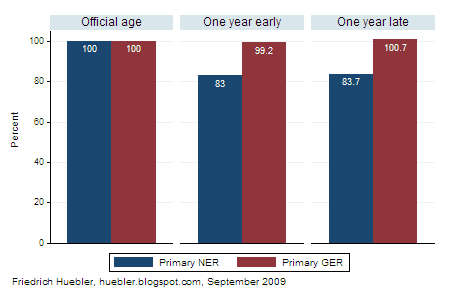
In an ideal situation, when all or almost all children enter primary school at the official entrance age and graduate after the official duration of primary school, both the NER and GER are near 100 percent. However, as demonstrated with data for Japan, a primary NER and GER of 100 percent is not a necessary condition for universal primary education. In countries where children enter school before or after the official entrance age, universal primary education can exist although the primary NER may be below 100 percent.
Related articles
External links
Friedrich Huebler, 29 September 2009, Creative Commons License
Permanent URL: http://huebler.blogspot.com/2009/09/upe.html
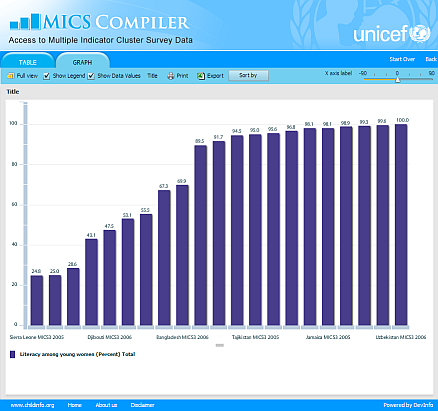
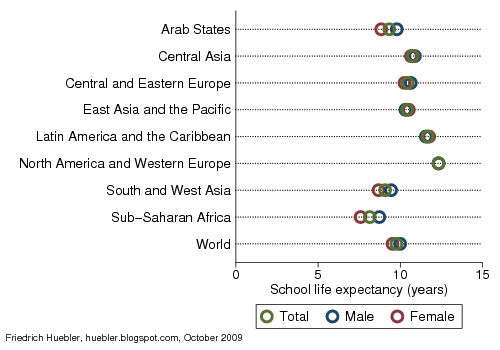

 The
The 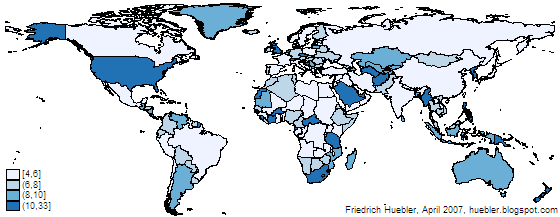
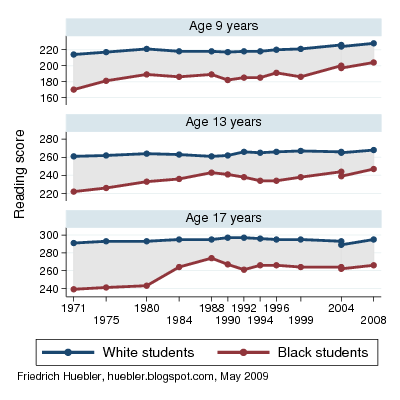
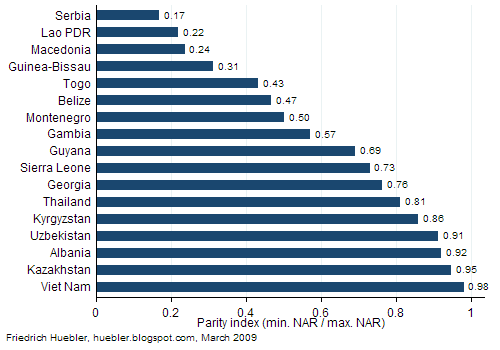
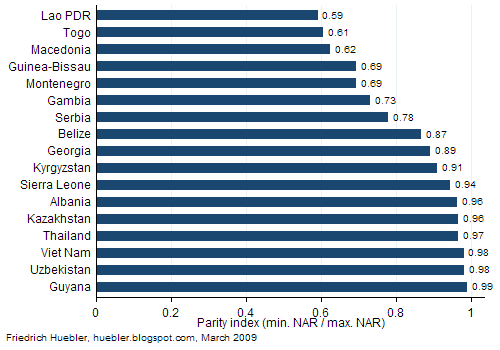
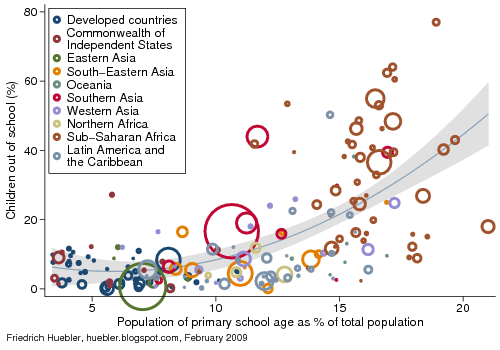

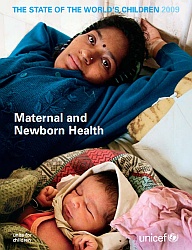 The 2009 edition of
The 2009 edition of 